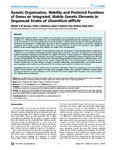Genetic Organisation, Mobility and Predicted Functions of Genes on Integrated, Mobile Genetic Elements in Sequenced Strains of Clostridium difficile
| dc.contributor.author | Brouwer, MSM | |
| dc.contributor.author | Warburton, Philip | |
| dc.contributor.author | Roberts, AP | |
| dc.contributor.author | Mullany, P | |
| dc.contributor.author | Allan, E | |
| dc.date.accessioned | 2015-10-14T11:34:34Z | |
| dc.date.available | 2015-10-14T11:34:34Z | |
| dc.date.issued | 2011-08-18 | |
| dc.identifier.issn | 1932-6203 | |
| dc.identifier.issn | 1932-6203 | |
| dc.identifier.other | ARTN e23014 | |
| dc.identifier.uri | http://hdl.handle.net/10026.1/3629 | |
| dc.description.abstract |
BACKGROUND: Clostridium difficile is the leading cause of hospital-associated diarrhoea in the US and Europe. Recently the incidence of C. difficile-associated disease has risen dramatically and concomitantly with the emergence of 'hypervirulent' strains associated with more severe disease and increased mortality. C. difficile contains numerous mobile genetic elements, resulting in the potential for a highly plastic genome. In the first sequenced strain, 630, there is one proven conjugative transposon (CTn), Tn5397, and six putative CTns (CTn1, CTn2 and CTn4-7), of which, CTn4 and CTn5 were capable of excision. In the second sequenced strain, R20291, two further CTns were described. RESULTS: CTn1, CTn2 CTn4, CTn5 and CTn7 were shown to excise from the genome of strain 630 and transfer to strain CD37. A putative CTn from R20291, misleadingly termed a phage island previously, was shown to excise and to contain three putative mobilisable transposons, one of which was capable of excision. In silico probing of C. difficile genome sequences with recombinase gene fragments identified new putative conjugative and mobilisable transposons related to the elements in strains 630 and R20291. CTn5-like elements were described occupying different insertion sites in different strains, CTn1-like elements that have lost the ability to excise in some ribotype 027 strains were described and one strain was shown to contain CTn5-like and CTn7-like elements arranged in tandem. Additionally, using bioinformatics, we updated previous gene annotations and predicted novel functions for the accessory gene products on these new elements. CONCLUSIONS: The genomes of the C. difficile strains examined contain highly related CTns suggesting recent horizontal gene transfer. Several elements were capable of excision and conjugative transfer. The presence of antibiotic resistance genes and genes predicted to promote adaptation to the intestinal environment suggests that CTns play a role in the interaction of C. difficile with its human host. | |
| dc.format.extent | e23014-e23014 | |
| dc.format.medium | Print-Electronic | |
| dc.language | en | |
| dc.language.iso | eng | |
| dc.publisher | Public Library of Science (PLoS) | |
| dc.subject | Bacterial Proteins | |
| dc.subject | Base Sequence | |
| dc.subject | Clostridioides difficile | |
| dc.subject | Conjugation, Genetic | |
| dc.subject | DNA Transposable Elements | |
| dc.subject | DNA, Bacterial | |
| dc.subject | DNA, Circular | |
| dc.subject | Gene Transfer, Horizontal | |
| dc.subject | Genes, Bacterial | |
| dc.subject | Humans | |
| dc.subject | Molecular Sequence Data | |
| dc.subject | Sequence Analysis, DNA | |
| dc.title | Genetic Organisation, Mobility and Predicted Functions of Genes on Integrated, Mobile Genetic Elements in Sequenced Strains of Clostridium difficile | |
| dc.type | journal-article | |
| dc.type | Journal Article | |
| dc.type | Research Support, Non-U.S. Gov't | |
| plymouth.author-url | https://www.webofscience.com/api/gateway?GWVersion=2&SrcApp=PARTNER_APP&SrcAuth=LinksAMR&KeyUT=WOS:000294126900007&DestLinkType=FullRecord&DestApp=ALL_WOS&UsrCustomerID=11bb513d99f797142bcfeffcc58ea008 | |
| plymouth.issue | 8 | |
| plymouth.volume | 6 | |
| plymouth.publication-status | Published online | |
| plymouth.journal | PLoS ONE | |
| dc.identifier.doi | 10.1371/journal.pone.0023014 | |
| plymouth.organisational-group | /Plymouth | |
| plymouth.organisational-group | /Plymouth/Faculty of Health | |
| plymouth.organisational-group | /Plymouth/Faculty of Health/School of Biomedical Sciences | |
| plymouth.organisational-group | /Plymouth/REF 2021 Researchers by UoA | |
| plymouth.organisational-group | /Plymouth/REF 2021 Researchers by UoA/UoA01 Clinical Medicine | |
| plymouth.organisational-group | /Plymouth/Users by role | |
| plymouth.organisational-group | /Plymouth/Users by role/Academics | |
| dc.publisher.place | United States | |
| dcterms.dateAccepted | 2011-07-08 | |
| dc.identifier.eissn | 1932-6203 | |
| dc.rights.embargoperiod | Not known | |
| rioxxterms.versionofrecord | 10.1371/journal.pone.0023014 | |
| rioxxterms.licenseref.uri | http://www.rioxx.net/licenses/all-rights-reserved | |
| rioxxterms.licenseref.startdate | 2011 | |
| rioxxterms.type | Journal Article/Review |


